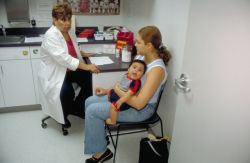Risk Factors
For some women, there is a greater chance of problems during pregnancy than for other women. Various factors have been identified to try to predict those women who will experience problems and those who will not. These are called risk factors.
Some risk factors are more significant than others. While most women with any of these risk factors will experience good outcomes, they may benefit from increased surveillance or additional resources.
| <a class="external" href="http://www.brooksidepress.org/Products/Military_OBGYN/images/02c2018.jpg" rel="nofollow" target="_blank">  </a> </a>
|
Moderate increase in risk:
- Age < 16 or > 35
- 2 spontaneous or induced abortions
- < 8th grade education
- > 5 deliveries
- Abnormal presentation
- Active TB
- Anemia (Hgb <10, Hct <30%)
- Chronic pulmonary disease
- Cigarette smoking
- Endocrinopathy
- Epilepsy
- Heart disease class I and II
- Infertility
- Infants > 4,000 gm
- Isoimmunization (ABO)
- Multiple pregnancy (at term)
- Poor weight gain
- Post-term pregnancy
- Pregnancy without family support
- Preterm labor (34-37 weeks)
- Previous hemorrhage
- Previous pre-eclampsia
- Previous preterm or SGA infant
- Pyelonephritis
- Rh negative
- Second pregnancy in 9 months
- Small pelvis
- Thrombophlebitis
- Uterine scar or malformation
- Venereal disease
| Greater than moderate increase in risk:- Age >40
- Bleeding in the 2nd or 3rd Trimester
- Diabetes
- Chronic renal disease
- Congenital anomaly
- Fetal growth retardation
- Heart disease class III or IV
- Hemoglobinopathy
- Herpes
- Hypertension
- Incompetent cervix
- Isoimmunization (Rh)
- Multiple pregnancy (pre-term)
- > 2 spontaneous abortions
- Polyhydramnios
- Premature rupture of membranes
- Pre-term labor (<34 weeks)
- Prior perinatal death
- Prior neurologically damaged infant
- Severe pre-eclampsia
- Significant social problems
- Substance abuse
|
Go back to obstetrics homepage
